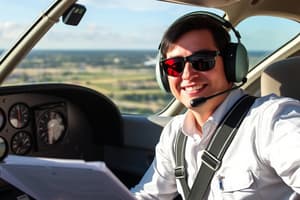Podcast
Questions and Answers
What is the primary purpose of the Private Pilot Check Ride?
What is the primary purpose of the Private Pilot Check Ride?
To assess a candidate's proficiency in flying and handling an aircraft for obtaining a Private Pilot Certificate.
List two key components that are evaluated during the flight test of the Private Pilot Check Ride.
List two key components that are evaluated during the flight test of the Private Pilot Check Ride.
Pre-flight inspection and takeoffs and landings.
Why is it important to review the Private Pilot Airman Certification Standards (ACS) before the check ride?
Why is it important to review the Private Pilot Airman Certification Standards (ACS) before the check ride?
It provides guidelines and specific expectations for knowledge and skills required for the check ride.
What are some common areas of concern that candidates should address before their check ride?
What are some common areas of concern that candidates should address before their check ride?
What should candidates bring to their check ride to ensure they are prepared?
What should candidates bring to their check ride to ensure they are prepared?
Describe the importance of remaining calm and professional during the check ride.
Describe the importance of remaining calm and professional during the check ride.
Flashcards are hidden until you start studying
Study Notes
Overview of Private Pilot Check Ride
- The check ride, or practical test, is the final step to obtain a Private Pilot Certificate.
- Conducted by a designated pilot examiner (DPE).
Components of the Check Ride
-
Oral Exam (Knowledge Test)
- Covers general aviation knowledge, regulations, and safety.
- Topics include:
- Flight operations
- Weather impacts
- Navigation
- Aircraft systems
- Aerodynamics
-
Flight Test (Practical Test)
- Conducted in the aircraft.
- Demonstrates proficiency in flying and handling the aircraft.
- Tasks include:
- Pre-flight inspection
- Takeoffs and landings
- Maneuvers (e.g., steep turns, stalls, slow flight)
- Navigation and cross-country flying
- Emergency procedures
Preparation Tips
- Review the Private Pilot Airman Certification Standards (ACS).
- Practice flight maneuvers with a flight instructor.
- Prepare for oral questions by studying relevant materials.
- Ensure familiarity with the aircraft being used for the test.
- Maintain a checklist for pre-flight and in-flight procedures.
Common Areas of Concern
- Communication with ATC (Air Traffic Control).
- Managing aircraft systems and understanding emergency protocols.
- Adhering to regulations and safety protocols.
Important Considerations
- Arrive early and have all required documents (e.g., logbook, medical certificate, government ID).
- Understand the examiner's expectations and the evaluation criteria.
- Remain calm and professional throughout the check ride.
Overview of Private Pilot Check Ride
- The practical test is the culminating step in obtaining a Private Pilot Certificate.
- A designated pilot examiner (DPE) administers the check ride.
Components of the Check Ride
-
Oral Exam (Knowledge Test)
- Evaluates general aviation knowledge and understanding of regulations and safety.
- Key topics include:
- Flight operations
- Effects of weather on flying
- Navigation principles
- Aircraft systems and their functions
- Fundamentals of aerodynamics
-
Flight Test (Practical Test)
- Conducted in-flight to assess flying proficiency.
- Key tasks include:
- Performing a thorough pre-flight inspection
- Executing successful takeoffs and landings
- Demonstrating flight maneuvers such as steep turns, stalls, and slow flight
- Navigating and executing cross-country flights
- Handling emergency procedures appropriately
Preparation Tips
- Review the Private Pilot Airman Certification Standards (ACS) to understand testing standards.
- Practice essential flight maneuvers with a qualified flight instructor for skill reinforcement.
- Familiarize with potential oral exam questions by studying relevant textbooks and materials.
- Ensure complete familiarity with the specific aircraft used during the test.
- Maintain and utilize a checklist for pre-flight and in-flight procedures to enhance organization.
Common Areas of Concern
- Effective communication with Air Traffic Control (ATC) is crucial.
- Proficient management of aircraft systems and a solid understanding of emergency protocols are essential.
- Strict adherence to aviation regulations and safety protocols is expected throughout the test.
Important Considerations
- Arrive well in advance, bringing all necessary documents including logbook, medical certificate, and government-issued ID.
- Understand and clarify the examiner's expectations and evaluation criteria before the check ride begins.
- Stay calm and maintain a professional demeanor during the entire assessment process.
Studying That Suits You
Use AI to generate personalized quizzes and flashcards to suit your learning preferences.




